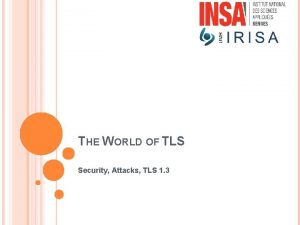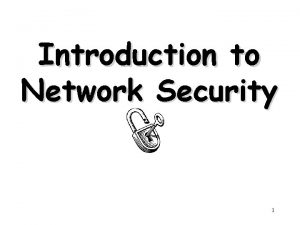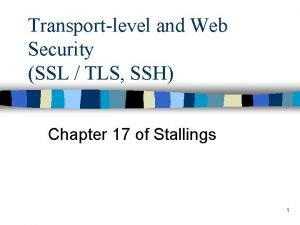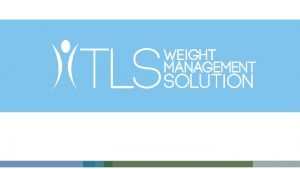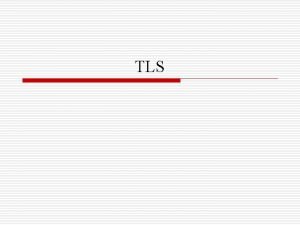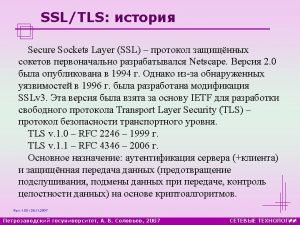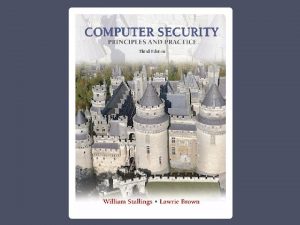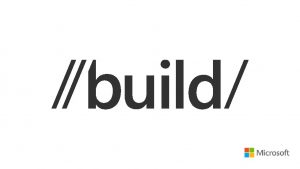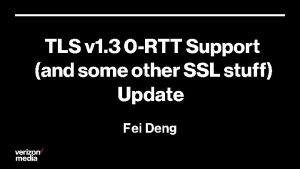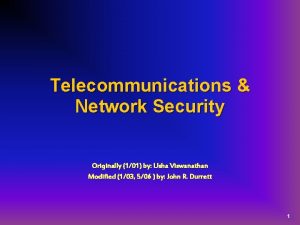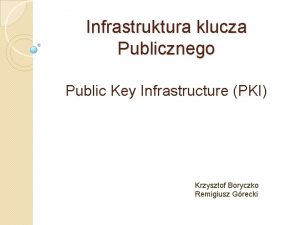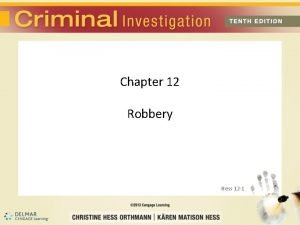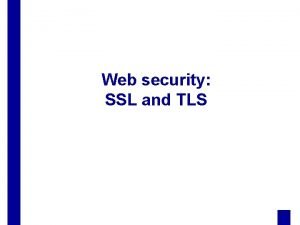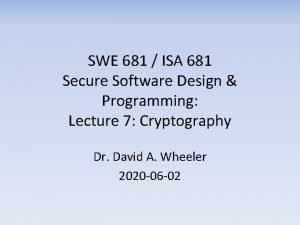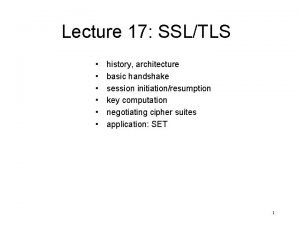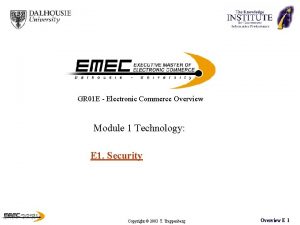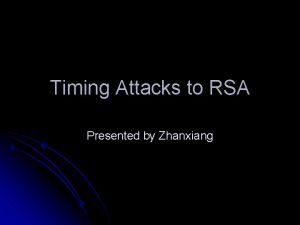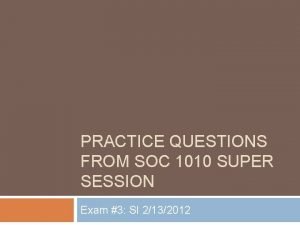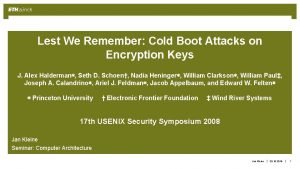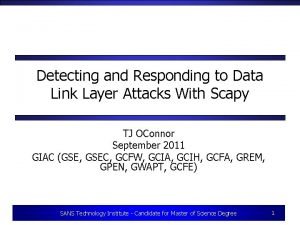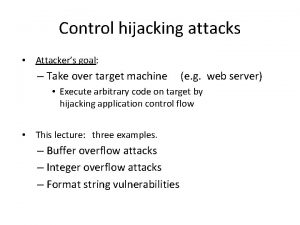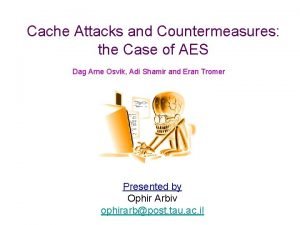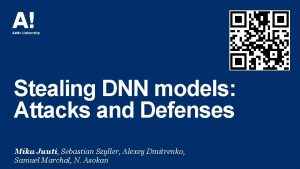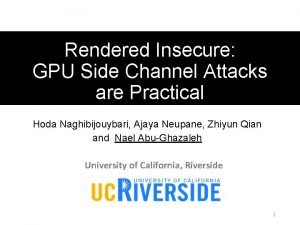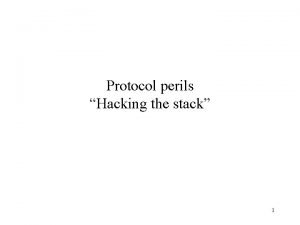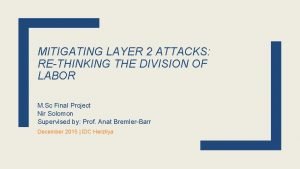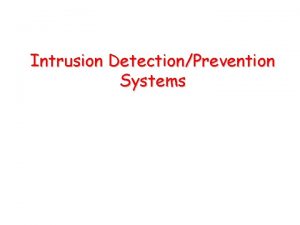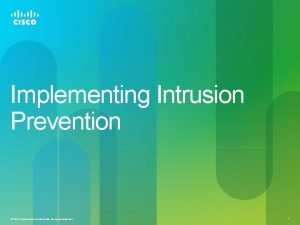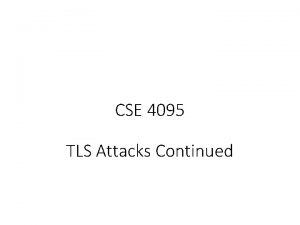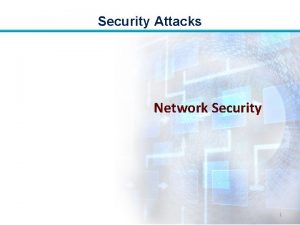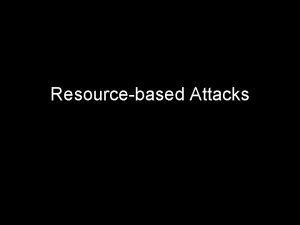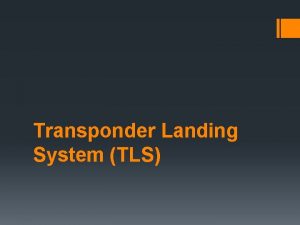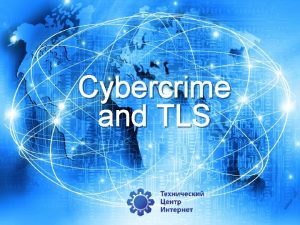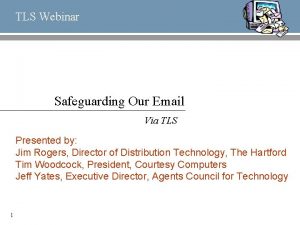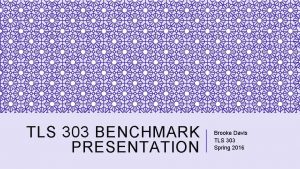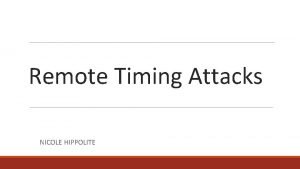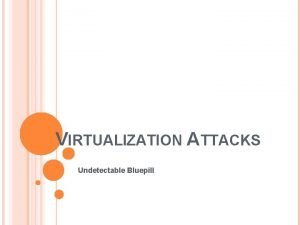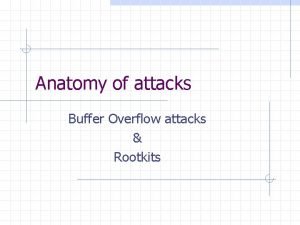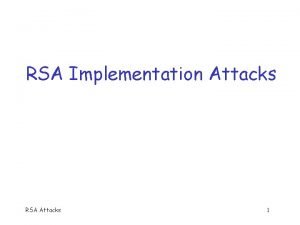THE WORLD OF TLS Security Attacks TLS 1





































- Slides: 37

THE WORLD OF TLS Security, Attacks, TLS 1. 3

HTTPS: // AND FTPS: // AND…. Ø Have you done any of the following today? § § § § E-shopping: Amazon, Ebay, Audible, … Checked your Email Visited a social networking site: Facebook, Twitter, … Used a secure FTP Used Voice over IP Used Google Used any URL strting with https: // and a green lock Congratulations, you’ve used TLS/SSL!

PART 1 ABOUT TLS/SSL

WHAT TLS DOES Ø

THE CLIENT-SERVER SCENARIO Ø

A BIT OFH ISTORY Ø Started out as Secure Socket Layer (SSL) § Developed by Netscape around 1995 § Main goal: secure communication over the Internet Ø Changed to Transport Layer Security (TLS) in 1999 § Secure communication over the Internet: https § … but also: secure file sharing (ftp), secure emailing etc. § Heavily standardised Ø Some implementations: § Open. SSL § Boring. SSL, mbed. TLS § s 2 n: TLS by Amazon

BIT OF A BLACK SHEEP Ø SSL 1. 0: never released (too insecure for release) Ø SSL 2. 0: released in Feb. 1995 “contained a number of security flaws” Ø SSL 3. 0: released in 1996, complete re-design from 2. 0 Ø TLS 1. 0: “no dramatic changes”, but “more secure” backward compatible: can relax to SSL 3. 0 Ø TLS 1. 1: some protection against CBC-mode attacks: explicit IV, better padding Ø TLS 1. 2: 1996 – first collusion attacks on MD 5; 2005: certificate forging; 2008: finally, TLS changes to SHA 1 and SHA-256; also adds AES-GCM

STRUCTURE OF TLS/SSL (UNILATERAL AUTH. ) Ø Intuition: If keys are “good”, then they should secure Record layer § Q 1: What is a “good” key? § Q 2: How do we encrypt and authenticate? §

THE TLS (1. 2) HANDSHAKE (AKE)

THE THREE MODES Ø TLS-RSA (most used): RSA public encryption key Decrypt with sk

THE THREE MODES Ø TLS-DH (second best):

THE THREE MODES Ø TLS-DHE (ephemeral DH): Fresh DH public key and matching group

KEY DERIVATION AND RENEGOTIATION Ø

SUMMARY: SOME CHARACTERISTICS OF TLS Ø

PART 2 PROVABLE SECURITY AND ATTACKS

WHAT IS A GOOD KEY? Ø Bellare-Rogaway security for key exchange: Real or Random keys Test

WHY BR SECURITY DOES NOT WORK Ø Problem: the Finished messages When the adversary gets the keys, she can test Real/Randomness by simulating Finished messages § If the key is confirmed, it’s real; else, it’s random § Ø Does this mean TLS is insecure? § § § No, it means we could not prove it secure for many years Breakthrough a few years ago Krawczyk, Paterson, Wee (2013): TLS 1. 2 is secure Bhargavan et al. (2014): TLS 1. 2 is secure even with session resumption and changing ciphersuites Kohlweiss et al. (2014): TLS 1. 2 is secure even in composition with other protocols

RECORD-LAYER SECURITY Ø Cipher Suites: Chosen by client when sending nonce § Define: key-exchange, sym. encryption, MAC, PRF § Choice of block or stream ciphers, hash functions, etc. § Ø Provable security: If you have good keys, IND-CPA-secure authenticated encryption, then this creates a secure channel § Problem 1: we don’t really know which cipher suites are IND-CPA secure § Problem 2: security models feature single-block msgs; real world msgs are multi-block and padded §

PROBLEMS WITH CBC-MODE Ø Why we like CBC mode: Efficient in practice: can decrypt a lot in constant memory and linear time § Just as good as ECB for efficiency, better security § Ø Some limits: Problems with choice of IV § CBC-MAC has problems with unforgeability § Ø More serious: attack by Vaudenay

VAUDENAY’S ATTACK Ø

BASIC ATTACK Ø

ERRORS THAT KILL (OPENSSH) Ø Encrypt-then-MAC is bad: Albrecht et al. Sequence number Packet length Padding length Payload Padding Encrypt MAC Ciphertext MAC

PLAINTEXT RECOVERY Ø Idea: § § § § Forget about the length being a length field Imagine you wanted to decrypt a ciphertext Start with one block of this ciphertext (which you want to decrypt), and send it as the first part of a new ciphertext Wait and see If no termination, then the packet passed the length check We learn 14 bits of plaintext Repeat this to get 32 bits, then more

HISTORY OF TLS ATTACKS Ø Renegotiation attack vs >SSL 3. 0: plaintext injection Ideal Patch: kill renegotiation/generate more entropy Real Patch: include previous session history Ø Version rollback attacks: use older, weaker version/cipher Ideal Patch: kill backward compatibility/weak ciphers Real Patch: ? ? ? (not an important/realistic attack) Ø BEAST: browser exploits of CBC vulnerabilities Ideal Patch: kill CBC mode/ kill < TLS 1. 2 Real Patch: fixed in TLS 1. 1, but even if client has TLS >1. 1, weak servers can force it to TLS 1. 0. Extra Patch: discouraged CBC mode encouraged RC 4…

MORE ATTACKS ON TLS Ø CRIME/BREACH: exploit compression characteristics Ideal Patch: kill data compression Real Patch: can kill some compression in TLS/SPDY headers; cannot kill HTTP compression (against BREACH) Ø Timing attacks/Lucky 13: exploit padding problems Ideal Patch: kill CBC mode Real Patch: encourage RC 4 instead of CBC mode TLS 1. 2 does offer one good ciphersuite: AES-GCM Ø POODLE: downgrade to SSL 3. 0 and exploit away Ideal Patch: kill backward compatibility Real Patch: close our eyes and hope it goes away?

AND EVEN MORE ATTACKS Ø RC 4 attacks: RC 4 output biased – NOT pseudorandom Attack specifics: 2014 – use many encryptions (234) and lots of generated traffic to do something à la BREACH/CRIME (on cookies) 2015 – use less encryptions (226) on pass words with 100 tries before lockout. Password recovery rate: 50% for pw length 6 for Basic. Auth (Chrome) Ideal Patch: kill RC 4 Real Patch: RFC 7465 prohibits RC 4 cipher suites. Real Deployment: 30% of SSL/TLS traffic still uses RC 41 74. 5% of sites allow RC 4 negotiation 2 few sites deploy TLS 1. 2, which means alternatives are just as bad… 1 ICSI Certificate Notary project; 2 SSL Pulse

DOES IT EVER STOP? Ø Heartbleed: does not affect SSL/TLS, rather Open. SSL Attack strategy: read memory of users with problematic ver sions of Open. SSL, essentially learning their long-term data Patch: do not use Open. SSL 1. 0. 1. to 1. 0. 1 f. Ø 3 Shake: S 1* forces same MSK in S 1* - A and S 1* - S 2 Attack strategy: use same PMK material in two sessions, then use session resumption (no certificates!) Ideal Patch: kill renegotiation and finite fields; use ECDHE Real Patch: not really all that much… Ø FREAK: force connection on weak parameters Ideal Patch: kill backward compatibility Real Patch: fix Open. SSL, preserve backward compatibility

THE LATEST BUG: LOGJAM Ø Export cipher suites: date back in the 90 s, feature small primes Can break DLog on those groups easily, thus forge connection

WHY LOGJAM WORKS Ø Export ciphers still exist Originally for exporting cipher suites outside the US § No longer really needed, but dormant in implementation § They look innocuous, like regular DH parameters § Ø Solving DLog on 512 -bit fields Usually servers use the same primes over and over again: break it once, you will know it next time § Generally takes longer than usual timeout of sessions… § … but we can feed the server nonsense messages to make it wait longer § Bhargavan et al. : 70 seconds to break DLog §

BUT… WASN’T TLS PROVABLY SECURE? Ø Security statement equivalent to: Ø In the ROM (or with weird assumptions), given: • A secure certification scheme (PKI) • A collision-resistant hash function • A PRF that is indistinguishable from random • A Strongly-unforgeable HMAC • Either CBC-mode block cipher that is a super PRP; or a stream cipher with PR output Ø Then: TLS-RSA, TLS-DHE secure How does that fit in with attacks?

GAP MODEL/REALITY Ø De-facto security model: • 1 server, perfect protocol implementation: Rules out 3 Shake, Heartbleed, Padding attacks Rules out cookie problems: BREACH/CRIME… • Does not capture changing ciphersuites/renegotiation Rules out FREAK, renegotiation, version rollback… Ø Reductions • Assuming CBC-mode block cipher that is a super PRP… … which is not true for TLS… • Assuming stream cipher with PR output… … DEFINITELY not true for RC 4… Close the gap or change the protocol

PART 3 TLS 1. 3

TLS 1. 3 (BASIC) TLS 1. 2 Client TLS 1. 3 Server* CHello Client* SCert Get PMK, keys Get PMK, keys (RSA, DHE) Check CHshake CFinished SFinished Check Server CHshake SHello SHshake CHello Get PMK, keys SHello Get PMK, keys (DHE) SHshake {Scert}MS SFinished Check

KEY DERIVATION TLS 1. 2 CHshake TLS 1. 3 SHshake CHshake SCert HKDF. Extract PMK HKDF. Expand PRFPMK(nonces) MSK htk m. ES m. SS fsk PRFMSK(nonces) Session keys HKDF. Extract MSK

MORE FEATURES OF TLS 1. 3 Ø

WHAT WE HAVE AND WHAT WE WANT Desired Changes Actual Changes • Kill backward compatibility • Advertised for TLS 1. 3 • Kill CBC mode • Done; de-facto is AEAD • Kill RC 4 • Done • Kill renegotiation • Modified it; unclear consequences • Kill finite fields (keep EC) • Done • Kill RSA mode • Under consideration • Kill data compression • Partial

PERSPECTIVES Ø TLS 1. 3 far from standardisation, even farther from deployment Ø Reluctance to learn from our mistakes: • MD 5 debacle; replacement only years after complete breakdown • TLS 1. 2: reluctance to adopt it, accept old versions • Even in TLS 1. 3, problematic points: renegotiation, circularities… • Limited security proofs for cipher suites Ø Model limitations: • still no accounting for changing cipher suites • limited leakage resilience and implementations • 1 -server scenario
 Attacks on tls
Attacks on tls Security attacks services and mechanisms
Security attacks services and mechanisms Provate security
Provate security Tls ssh
Tls ssh Tls weight management solution
Tls weight management solution 2tls
2tls Osi tls
Osi tls Encrypted traffic management
Encrypted traffic management Heartbeat alert chapter 22
Heartbeat alert chapter 22 Http2 tls
Http2 tls Tls weight management
Tls weight management Rtt
Rtt Protocollo aaa
Protocollo aaa Tls nic
Tls nic Tls error: unroutable control packet received from
Tls error: unroutable control packet received from Suszi wszib
Suszi wszib An indicator of a false robbery report is
An indicator of a false robbery report is Web security ssl
Web security ssl Fbi failed to verify tls certificate
Fbi failed to verify tls certificate Corset jewett indication
Corset jewett indication Handshake
Handshake Tls handshake
Tls handshake Timing attack rsa
Timing attack rsa Attacks on bilingualism represent an ethnocentric
Attacks on bilingualism represent an ethnocentric Lest we remember: cold boot attacks on encryption keys
Lest we remember: cold boot attacks on encryption keys Docker whoami
Docker whoami Deauth attack
Deauth attack What is an attacker's goal in hijacking attacks
What is an attacker's goal in hijacking attacks Malicious attacks threats and vulnerabilities
Malicious attacks threats and vulnerabilities Cache attacks and countermeasures: the case of aes
Cache attacks and countermeasures: the case of aes Mika juuti
Mika juuti Paralleism
Paralleism Dns spoofing
Dns spoofing On adaptive attacks to adversarial example defenses
On adaptive attacks to adversarial example defenses Layer 2 attacks
Layer 2 attacks Zero-day attacks
Zero-day attacks Zero-day attacks
Zero-day attacks Icd 10 anxiety with panic attacks
Icd 10 anxiety with panic attacks
